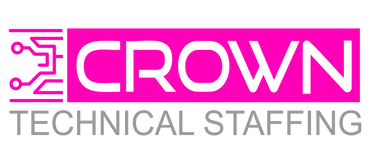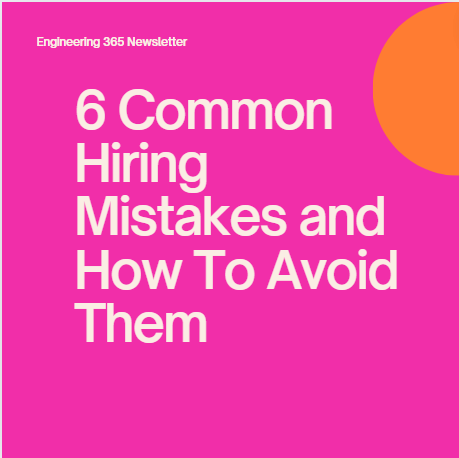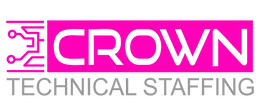As the owner of a small, niche recruitment firm, compiling a list of the ‘most common hiring mistakes’ hits home. In this edition of “Engineering 365”, we’re tackling the six major hiring mistakes – some we’ve made ourselves and others we’ve observed our clients make – and exactly how to avoid them.
During the early stages of Crown Technical, I often found myself saying, “This person isn’t going to work out” more than I’d like to admit. It took us about 12 months to fully understand the “science” behind creating the right hiring system for our team.
This topic is invaluable, as a hiring mistake can cost your company hundreds of thousands of dollars in lost time, money, and opportunity.
These 6 mistakes are not all my own, but a good student is always learning, so I’ve included observations along the journey.
1. Not Defining Job Duties and Required Skills Clearly
One of the biggest hiring mistakes is not being crystal clear on job duties and the required skills. Different duties require different skills, and a vague job description can lead to hiring the wrong candidate.
Example and Tip:
Define the role, the expected outcomes, existing resources, and the gaps that the new hire is expected to fill. Before you schedule the interview you should outline not only the current department/team status but also the growth trajectory and potential challenges, emphasizing the importance of the individual’s role in the company’s future.
“Here’s where we’re trying to go. Here are the outcomes that we’re looking to achieve. Here’s what’s already in place. Here’s what’s missing. Here’s what we don’t know and are trying to figure out. AND this is what we need from you.”
Action Step:
Update your job descriptions to include detailed expectations, such as the number of suppliers and vendors managed, the mix of inbound and outbound responsibilities, and any specific skills required.
2. Asking Closed-Ended Questions
Avoid asking close-ended questions during interviews, as they can lead to incomplete or misleading answers. Instead, ask open-ended questions to get a fuller picture of the candidate’s skills and experience.
Example and Tip:
“Switch from ‘Have you led client-facing presentations?’ to ‘Describe your experience selling capital equipment to clients in the food and beverage sector, including the challenges and successes you encountered.’”
Action Step:
Revise your interview questions to be open-ended, prompting candidates to share detailed stories about their experiences and successes.
3. Inconsistent Interview Questions
Ask the same set of questions to every candidate to identify patterns and ensure a fair evaluation process. This consistency helps you compare candidates effectively and avoid biases.
Example and Tip:
“Develop a standard interview guide with key questions that all interviewers use, ensuring consistency in the evaluation process.”
“Hiring should be fairly boring for you as the hiring manager because you want to look for patterns, and you can’t find patterns if you’re asking different questions each time.”
Action Step:
Create a standardized interview guide and ensure all interviewers follow it to maintain consistency and fairness in the evaluation process.
4. Lacking an Evaluation Method
Establish what good looks like before interviewing candidates. Create a scoring system to objectively evaluate each response, ensuring you have a uniform method to compare and decide upon candidates.
Example and Tip:
“Create a rubric with categories like communication skills, experience relevance, and cultural fit, rating each on a scale from 1 to 5.”
“If at the end of each stage, you can look at the score and make a decision right then and there, this person moves on, this person does not. It’s objective and removes second guessing.”
Action Step:
Develop a detailed evaluation rubric that all interviewers use to score candidates, making the hiring process more objective and transparent.
5. Lengthy Hiring Process
Avoid dragging out the hiring process or wanting to evaluate too many candidates before making a decision. This leads to losing great candidates to faster-moving companies.
Example and Tip:
“Set a timeline for the hiring process, aiming to complete it within four weeks. Communicate this timeline to candidates at the beginning.”
“If you find someone 90% of the way there, extend your offer, get them in the door, and get it done.”
Action Step:
Streamline your hiring process and set a clear timeline. Be ready to make decisions quickly and communicate effectively with candidates throughout the process.
6. Not Selling the Role and the Company
The best candidates often aren’t actively looking for a job. Make sure you sell your company and the role to them, highlighting the exciting aspects and vision of the company.
Example and Tip:
“Spend the last 10 minutes of the interview discussing the company’s vision, recent successes, and future opportunities. Share personal stories of growth within the company.”
Be prepared to answer a few of these questions:
✔ How does the company support professional growth & development?
✔ What resources does the company provide to support mental health?
✔ Can you share an example of an employee who grew within the company?
✔ What are some ways that success will be measured in the first 90 days? First year?
✔ What are the common themes that you find amongst your highest performers?
“You have to convince them why they should leave the comfort of their current role or select your company over the other companies they’re evaluating.”
Action Step:
Dedicate time in each interview to sell the role and your company, sharing success stories and the exciting potential to attract top talent.
Hiring right the first time is challenging but achievable with clear definitions, consistent evaluations, and a proactive approach to selling the role. Implement these strategies to improve your hiring success rate and build a stronger team. Remember that hiring is a journey of continuous improvement—always be willing to learn and adapt. Start implementing these changes today and see the positive impact on your organization.
Here are three ways that we can help…
CTS carries out deep talent mapping, nationwide, to ensure our shortlists contain only the very best leaders for your Engineering and Manufacturing teams.
1. We help to attract and retain the best candidates, specifically for your team, in addition to the frontline leaders that you’ll need for growth and stability.
2. Reduce the cost of acquiring and training new hires by supporting and enhancing the efforts of your onboarding team for the first 90 days.
3. Provide a zero-risk and no-cost assessment of your hiring strategies with a 15-minute consultation.
Ready to elevate your talent and hiring strategy? Explore our latest tool tailored for VPs and Directors in the manufacturing sector. In just 2 minutes, gain insights to boost engagement and help reduce turnover. In addition, receive a customized report for your team.
See the link below.


